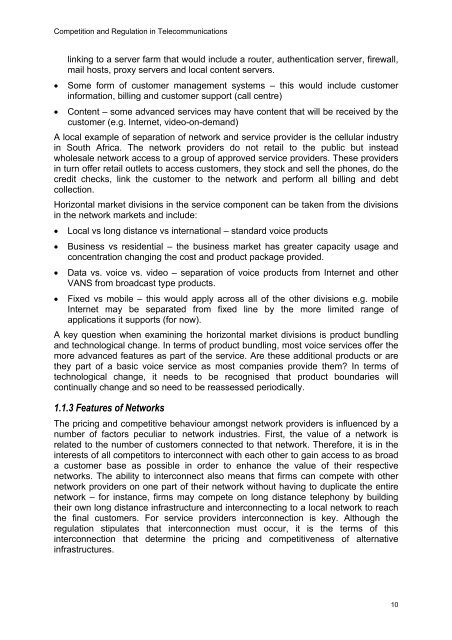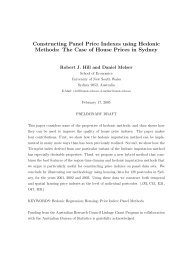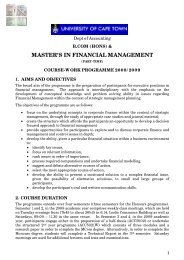Competition and Regulation in the Telecommunications Industry in ...
Competition and Regulation in the Telecommunications Industry in ...
Competition and Regulation in the Telecommunications Industry in ...
You also want an ePaper? Increase the reach of your titles
YUMPU automatically turns print PDFs into web optimized ePapers that Google loves.
<strong>Competition</strong> <strong>and</strong> <strong>Regulation</strong> <strong>in</strong> <strong>Telecommunications</strong>l<strong>in</strong>k<strong>in</strong>g to a server farm that would <strong>in</strong>clude a router, au<strong>the</strong>ntication server, firewall,mail hosts, proxy servers <strong>and</strong> local content servers.• Some form of customer management systems – this would <strong>in</strong>clude customer<strong>in</strong>formation, bill<strong>in</strong>g <strong>and</strong> customer support (call centre)• Content – some advanced services may have content that will be received by <strong>the</strong>customer (e.g. Internet, video-on-dem<strong>and</strong>)A local example of separation of network <strong>and</strong> service provider is <strong>the</strong> cellular <strong>in</strong>dustry<strong>in</strong> South Africa. The network providers do not retail to <strong>the</strong> public but <strong>in</strong>steadwholesale network access to a group of approved service providers. These providers<strong>in</strong> turn offer retail outlets to access customers, <strong>the</strong>y stock <strong>and</strong> sell <strong>the</strong> phones, do <strong>the</strong>credit checks, l<strong>in</strong>k <strong>the</strong> customer to <strong>the</strong> network <strong>and</strong> perform all bill<strong>in</strong>g <strong>and</strong> debtcollection.Horizontal market divisions <strong>in</strong> <strong>the</strong> service component can be taken from <strong>the</strong> divisions<strong>in</strong> <strong>the</strong> network markets <strong>and</strong> <strong>in</strong>clude:• Local vs long distance vs <strong>in</strong>ternational – st<strong>and</strong>ard voice products• Bus<strong>in</strong>ess vs residential – <strong>the</strong> bus<strong>in</strong>ess market has greater capacity usage <strong>and</strong>concentration chang<strong>in</strong>g <strong>the</strong> cost <strong>and</strong> product package provided.• Data vs. voice vs. video – separation of voice products from Internet <strong>and</strong> o<strong>the</strong>rVANS from broadcast type products.• Fixed vs mobile – this would apply across all of <strong>the</strong> o<strong>the</strong>r divisions e.g. mobileInternet may be separated from fixed l<strong>in</strong>e by <strong>the</strong> more limited range ofapplications it supports (for now).A key question when exam<strong>in</strong><strong>in</strong>g <strong>the</strong> horizontal market divisions is product bundl<strong>in</strong>g<strong>and</strong> technological change. In terms of product bundl<strong>in</strong>g, most voice services offer <strong>the</strong>more advanced features as part of <strong>the</strong> service. Are <strong>the</strong>se additional products or are<strong>the</strong>y part of a basic voice service as most companies provide <strong>the</strong>m? In terms oftechnological change, it needs to be recognised that product boundaries willcont<strong>in</strong>ually change <strong>and</strong> so need to be reassessed periodically.1.1.3 Features of NetworksThe pric<strong>in</strong>g <strong>and</strong> competitive behaviour amongst network providers is <strong>in</strong>fluenced by anumber of factors peculiar to network <strong>in</strong>dustries. First, <strong>the</strong> value of a network isrelated to <strong>the</strong> number of customers connected to that network. Therefore, it is <strong>in</strong> <strong>the</strong><strong>in</strong>terests of all competitors to <strong>in</strong>terconnect with each o<strong>the</strong>r to ga<strong>in</strong> access to as broada customer base as possible <strong>in</strong> order to enhance <strong>the</strong> value of <strong>the</strong>ir respectivenetworks. The ability to <strong>in</strong>terconnect also means that firms can compete with o<strong>the</strong>rnetwork providers on one part of <strong>the</strong>ir network without hav<strong>in</strong>g to duplicate <strong>the</strong> entirenetwork – for <strong>in</strong>stance, firms may compete on long distance telephony by build<strong>in</strong>g<strong>the</strong>ir own long distance <strong>in</strong>frastructure <strong>and</strong> <strong>in</strong>terconnect<strong>in</strong>g to a local network to reach<strong>the</strong> f<strong>in</strong>al customers. For service providers <strong>in</strong>terconnection is key. Although <strong>the</strong>regulation stipulates that <strong>in</strong>terconnection must occur, it is <strong>the</strong> terms of this<strong>in</strong>terconnection that determ<strong>in</strong>e <strong>the</strong> pric<strong>in</strong>g <strong>and</strong> competitiveness of alternative<strong>in</strong>frastructures.10
















